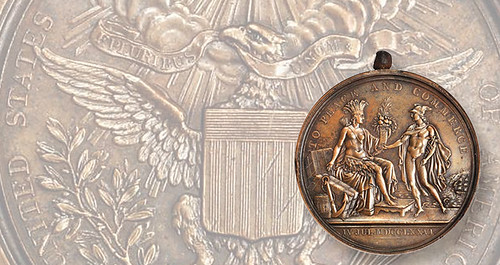
PREV ARTICLE
NEXT ARTICLE
FULL ISSUE
PREV FULL ISSUE
THE U.S. DIPLOMATIC MEDAL
An October 14, 2015 article by John Kraljevich published in Coin World discusses the recently sold U.S. Diplomatic medal in
bronze, one of four survivors struck in Paris. Here's an excerpt. -Editor

Originally conceived by Thomas Jefferson and personally approved by George Washington, the Diplomatic Medal was intended to be struck in gold and used as the official gift of the United States to recognize foreign diplomats for their service. Such gifts were customary at the time: John Adams received a large gold medal from the Netherlands in 1788 to recognize his service as minister plenipotentiary, a medal that survives in the collections of the Massachusetts Historical Society. When Jefferson returned from Paris in 1789 and was elevated to the position of secretary of state, he left his post in the hands of William Short, his longtime deputy. Soon thereafter, with gifts he had received from the French still fresh in his mind, Jefferson hatched his idea for a substantial gold medal, to be hung on a large gold chain whose length depended upon the diplomat’s term of service. The gold chain would be tantamount to a cash gift, but the medal could be retained as a keepsake. Corresponding with Short in Paris, Jefferson asked that the medal be executed by Augustin Dupré, who had earlier gained fame among the Americans for his work on the Libertas Americana medal and several of the medals voted by Congress to recognize military success during the American Revolution. Though records show two gold medals were struck, neither has survived. Both medals were given to French aristocrats who served as ambassadors to America, and scholars today assume they were destroyed during the French Revolution. The surviving paper trail also indicates that six bronze medals were struck. Four of those are known today: one in Princeton University, three more in private collections. The finest of them, and the only one to retain its original loop, was recently sold in an October 1 Stack’s Bowers Galleries auction for $188,000. To read the complete article, see:
Wayne Homren, Editor The Numismatic Bibliomania Society is a non-profit organization promoting numismatic literature. See our web site at coinbooks.org. To submit items for publication in The E-Sylum, write to the Editor at this address: whomren@gmail.com To subscribe go to: https://my.binhost.com/lists/listinfo/esylum All Rights Reserved. NBS Home Page Contact the NBS webmaster 
|